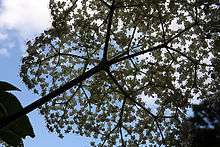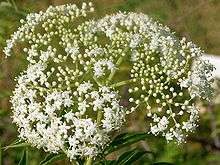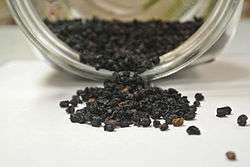Sambucus
| Sambucus | |
|---|---|
 | |
| European black elder (Sambucus nigra) | |
| Scientific classification | |
| Kingdom: | Plantae |
| (unranked): | Angiosperms |
| (unranked): | Eudicots |
| (unranked): | Asterids |
| Order: | Dipsacales |
| Family: | Adoxaceae |
| Genus: | Sambucus L.[1] |
| Species | |
|
See text | |
Sambucus is a genus of flowering plants in the family Adoxaceae. The various species are commonly called elder or elderberry. The genus was formerly placed in the honeysuckle family, Caprifoliaceae, but was reclassified due to genetic and morphological comparisons to Adoxa. In Sambucus, there are between 5 and 30 species of deciduous shrubs, small trees and herbaceous perennial plants.
The genus occurs in temperate to subtropical regions of the world. More widespread in the Northern Hemisphere, its Southern Hemisphere occurrence is restricted to parts of Australasia and South America. Many species are widely cultivated for their ornamental leaves, flowers and fruit.[2]
The leaves are pinnate with 5–9 leaflets (rarely 3 or 11). Each leaf is 5–30 cm (2.0–11.8 in) long, and the leaflets have serrated margins. They bear large clusters of small white or cream-colored flowers in late spring; these are followed by clusters of small black, blue-black, or red berries (rarely yellow or white).
Species groups



- The black-berried elder complex is variously treated as a single species Sambucus nigra found in the warmer parts of Europe and North America with several regional varieties or subspecies, or else as a group of several similar species. The flowers are in flat corymbs, and the berries are black to glaucous blue; they are larger shrubs, reaching 3–8 m (9.8–26.2 ft) tall, occasionally small trees up to 15 m (49 ft) tall and with a stem diameter of up to 30–60 cm (12–24 in).
- Sambucus australis (southern elder; South America)
- Sambucus canadensis (syn. S. nigra ssp canadensis; American elder; eastern North America; with blue-black berries)
- Sambucus cerulea (syn. S. caerulea, S. coerula, S. glauca; blue elderberry, nō-kōm-hē-i'-nē, Konkow language[3]); western North America; dark blue-black berries with glaucous bloom on surface, giving them a sky-blue appearance.
- Sambucus javanica (Chinese elder; southeastern Asia)
- Sambucus nigra (elder or black elder; Europe and western Asia; with black berries) This is the species most often used medicinally.
- Sambucus lanceolata (Madeira elder; Madeira Island; with black berries)
- Sambucus mexicana (Mexican elder; Sonoran Desert; with black berries)
- Sambucus palmensis (Canary Islands elder; Canary Islands; with black berries)
- Sambucus peruviana (Peruvian elder; northwest South America; with black berries)
- Sambucus simpsonii (Florida elder; southeastern United States; with blue-black berries)
- Sambucus velutina (velvet elder; southwestern North America; with blue-black berries)
- The blackberry elder Sambucus melanocarpa of western North America is intermediate between the preceding and next groups. The flowers are in rounded panicles, but the berries are black; it is a small shrub, rarely exceeding 3–4 m (9.8–13.1 ft) tall. Some botanists include it in the red-berried elder group.
- The red-berried elder complex is variously treated as a single species Sambucus racemosa found throughout the colder parts of the Northern Hemisphere with several regional varieties or subspecies, or else as a group of several similar species. The flowers are in rounded panicles, and the berries are bright red; they are smaller shrubs, rarely exceeding 3–4 m (9.8–13.1 ft) tall.
- Sambucus callicarpa (Pacific Coast red elderberry; west coast of North America)
- Sambucus chinensis (Chinese red elder; eastern Asia, in mountains)
- Sambucus latipinna (Korean red elder; Korea, southeast Siberia)
- Sambucus microbotrys (mountain red elder; southwest North America, in mountains)
- Sambucus pubens (American red elder; northern North America)
- Sambucus racemosa (European red elder or red-berried elder; northern Europe, northwest Asia, central North America)
- Sambucus sieboldiana (Japanese red elder; Japan and Korea)
- Sambucus tigranii (Caucasus red elder; southwest Asia, in mountains)
- Sambucus williamsii (North China red elder, "jie gu mu," 接骨木; northeast Asia)
- The Australian elder group comprises two species from Australasia. The flowers are in rounded panicles, and the berries white or yellow; they are shrubs growing to 3 m (9.8 ft) high.
- Sambucus australasica (yellow elder; New Guinea, eastern Australia)
- Sambucus gaudichaudiana (Australian elder or white elder; shady areas of south eastern Australia)
- The dwarf elders are, by contrast to the other species, herbaceous plants, producing new stems each year from a perennial root system; they grow to 1.5–2 m (4.9–6.6 ft) tall, each stem terminating in a large flat umbel which matures into a dense cluster of glossy berries.
- Sambucus adnata (Asian dwarf elder; Himalaya and eastern Asia; berries red)
- Sambucus ebulus (European dwarf elder; central and southern Europe, northwest Africa and southwest Asia; berries black)
Other species:
- Sambucus melanocarpa Gray (western elder)[4]
- Sambucus neomexicana Wooton (New Mexico elder)[4]
- Sambucus velutina Dur. & Hilg. (velvet elder; mountains of western Arizona)[4]
Cultivation
Ornamental varieties of Sambucus are grown in gardens for their showy flowers, fruits and lacy foliage. Native species of elderberry are often planted by people wishing to support native butterfly and bird species.
Uses
| Nutritional value per 100 g (3.5 oz) | |
|---|---|
| Energy | 305 kJ (73 kcal) |
|
18.4 g | |
| Dietary fiber | 7 g |
|
0.5 g | |
|
0.66 g | |
| Vitamins | |
| Vitamin A equiv. |
(4%) 30 μg |
| Thiamine (B1) |
(6%) 0.07 mg |
| Riboflavin (B2) |
(5%) 0.06 mg |
| Niacin (B3) |
(3%) 0.5 mg |
| Pantothenic acid (B5) |
(3%) 0.14 mg |
| Vitamin B6 |
(18%) 0.23 mg |
| Folate (B9) |
(2%) 6 μg |
| Vitamin C |
(43%) 36 mg |
| Minerals | |
| Calcium |
(4%) 38 mg |
| Iron |
(12%) 1.6 mg |
| Magnesium |
(1%) 5 mg |
| Phosphorus |
(6%) 39 mg |
| Potassium |
(6%) 280 mg |
| Zinc |
(1%) 0.11 mg |
| Other constituents | |
| Water | 79.80 g |
|
| |
| |
|
Percentages are roughly approximated using US recommendations for adults. Source: USDA Nutrient Database | |
Elderberry fruit or flowers are used as dietary supplements for minor diseases such as flu, colds, constipation, and other conditions, often served as a tea, extract, or in a capsule.[5] There is insufficient research to know its effectiveness for such uses or its safety profile.[5]
Nutrition
Raw elderberries are 80% water, 18% carbohydrates, and less than 1% each of protein and fat (table). In a 100 gram amount, elderberries supply 73 calories and are a rich source of vitamin C, providing 43% of the Daily Value (DV). Elderberries also have moderate contents of vitamin B6 (18% DV) and iron (12% DV), with no other nutrients in significant content (table).
Food
The French, Austrians and Central Europeans produce elderflower syrup, commonly made from an extract of elderflower blossoms, which is added to Palatschinken filling instead of blueberries. People throughout much of Central, Eastern, and Southeastern Europe use a similar method to make a syrup which is diluted with water and used as a drink or as a flavoring in several food products. In Germany, yoghurt desserts are made with both the berries and the flowers.[6] Fruit pies and relishes are produced with berries. In Italy (especially in Piedmont), Germany and Austria, the umbels of the elderberry are batter coated, fried and then served as a dessert or a sweet lunch with a sugar and cinnamon topping, known as "Hollerküchel".
Every year, Romanians produce a traditional soft drink in May and June called "socată" or "suc de soc". It is produced by letting the flowers macerate with water, yeast and lemon for 2–3 days. The last stage of fermentation is done in a closed pressure proof bottle to produce a fizzy drink. The beverage has also inspired Coca-Cola to launch an elderflower-based drink, Fanta Shokata.[7]
The flowers of Sambucus nigra are used to produce elderflower cordial. St. Germain, a French liqueur, is made from elderflowers. Hallands Fläder, a Swedish akvavit, is flavoured with elderflowers. Despite the similarity in name, the Italian liqueur sambuca is mostly made with star anise and fennel essential oils extracted by vapor distillation. It also contains elderflower extracts with which it is flavored to add a floral note, to smooth and round off the strong licorice flavor.
Hollowed elderberry twigs have traditionally been used as spiles to tap maple trees for syrup.[8]
Potential toxicity
Although the ripe, cooked berries (pulp and skin) of most species of Sambucus are edible,[5][9][10] uncooked berries and other parts of plants from this genus are poisonous.[11] Sambucus nigra is the only variety considered to be non-toxic, but it is still recommended that its berries be cooked slightly for culinary purposes.[9] The leaves, twigs, branches, seeds, and roots of Sambucus plants can contain a cyanidin glycoside. Ingesting a sufficient quantity of cyanidin glycosides may produce illnesses.[5][11]
In 1984, a group of twenty-five people were made sick, apparently by elderberry juice pressed from fresh, uncooked Sambucus mexicana berries, leaves, and stems. However, all twenty-five recovered quickly, including one individual who was hospitalized after drinking five glasses.[12]
Folk medicine

Black elderberry has been used medicinally for hundreds of years.[13][14] Some preliminary studies suggest that elderberry may have a measurable effect in treating the flu, alleviating allergies, and boosting overall respiratory health.[15]
Elder is used in traditional Chinese medicine, dissolved in wine, for rheumatism and traumatic injury.[16]
Ecology
The berries are a very valuable food resource for many birds. In Northern California elderberries are a favorite food for migrating band-tailed pigeons. Flocks can strip an entire bush in less than an hour. Elders are used as food plants by the larvae of some Lepidoptera species including brown-tail, buff ermine, dot moth, emperor moth, engrailed moth, swallow-tailed moth and the V-pug. The crushed foliage and immature fruit have a strong fetid smell.
Valley elderberry longhorn beetles in California are very often found around red or blue elderberry bushes. Females lay their eggs on the bark. Larvae hatch and burrow into the stems.
Dead elder wood is the preferred habitat of the mushroom Auricularia auricula-judae, also known as "Jew's ear fungus".[17]
The pith of elder has been used by watchmakers for cleaning tools before intricate work.[18]
Habitat
Elder commonly grows near farms and homesteads. It is a nitrogen-loving plant and thus thrives near places of organic waste disposal. Elders are often grown as a hedgerow plant in Britain since they take very fast, can be bent into shape easily and grow quite profusely, thus having gained the reputation of being 'an instant hedge'. It is not fussy about soil type or pH level and will virtually grow anywhere where it gets enough light.[19]
Folklore
Folklore is extensive and can be wildly conflicting depending on region.
- In some areas, the "elder tree" was supposed to ward off evil influence and give protection from witches, while other beliefs say that witches often congregate under the plant, especially when it is full of fruit.
- If an elder tree was cut down, a spirit known as the Elder Mother would be released and take her revenge. The tree could only safely be cut while chanting a rhyme to the Elder Mother.[20]
References
- ↑ "Sambucus L.". Germplasm Resource Information Network. United States Department of Agriculture. 2005-10-13. Retrieved 2009-07-23.
- ↑ RHS A-Z encyclopedia of garden plants. United Kingdom: Dorling Kindersley. 2008. p. 1136. ISBN 1-4053-3296-4.
- ↑ Chestnut, Victor King (1902). Plants used by the Indians of Mendocino County, California. Government Printing Office. p. 407. Retrieved 24 August 2012.
- 1 2 3 Kearney, T.H. & R. H. Peebles. 1960. Arizona Flora. University of California Press. Berkeley, CA.
- 1 2 3 4 "European elder". National Center for Complementary and Integrative Health, U.S. Department of Health & Human Services, National Institutes of Health. September 2016. Retrieved 8 November 2016.
- ↑ Mild elderberry Demeter yoghurt 3.7% 500g from Andechser Molkerei
- ↑ Fanta Shokata, Coca-Cola HBC Austria GmbH, 2015, retrieved 6 May 2016
- ↑ Medve, Richard J. et al. Edible Wild Plants of Pennsylvania and Neighboring States Penn State Press, 1990, ISBN 978-0-271-00690-1, p.161
- 1 2 McVicar, Jekka (2007). "Jekka's Complete Herb Book" p. 214–215. Raincoast Books, Vancouver. ISBN 1-55192-882-5
- ↑ Nova Scotia Museum Website, Poison plant section, Nova Scotia Museum – Poisonous plants
- 1 2 Senica, M; Stampar, F; Veberic, R; Mikulic-Petkovsek, M (2016). "The higher the better? Differences in phenolics and cyanogenic glycosides in Sambucus nigra leaves, flowers and berries from different altitudes". Journal of the Science of Food and Agriculture. doi:10.1002/jsfa.8085. PMID 27734518.
- ↑ Centers for Disease Control (CDC) (April 6, 1984). "Poisoning from Elderberry Juice—California". Morbidity and Mortality Weekly Report. Centers for Disease Control and Prevention. 33 (13): 173–174. PMID 6422238. Retrieved December 15, 2012.
- ↑ Thole, Julie M.; Kraft, Tristan F. Burns; Sueiro, Lilly Ann; et al. (2006). "A Comparative Evaluation of the Anticancer Properties of European and American Elderberry Fruits". Journal of Medicinal Food. 9 (4): 498–504. doi:10.1089/jmf.2006.9.498. PMID 17201636.
- ↑ A Modern Herbal | Elder. Botanical.com (1923-01-06). Retrieved on 2011-03-06.
- ↑ Barak, V; Halperin, T; Kalickman, I (2001). "The effect of Sambucol, a black elderberry-based, natural product, on the production of human cytokines: I. Inflammatory cytokines". European cytokine network. 12 (2): 290–6. PMID 11399518.
- ↑ Flaws, Bob (1994). Chinese Medicinal Wines and Elixirs. Blue Poppy. ISBN 0-936185-58-9.
- ↑ Roger's Mushrooms: A. auricula-judae
- ↑ Materials used in construction and repair of watches
- ↑ Sacred Earth - Elder in profile
- ↑ Howard, Michael. Traditional Folk Remedies (Century, 1987); pp. 134–5
Further reading
- Vedel, H., & Lange, J. (1960). Trees and Bushes in Wood and Hedgerow. Methuen & Co Ltd.
- Abe, Shin; Motai, Hideyo; Tanaka, Hiroshi; Shibata, Mitsue; Kominami, Yohsuke; Nakashizuka, Tohru (2008). "Population maintenance of the short-lived shrub Sambucus in a deciduous forest". Ecology. 89 (4): 1155–1167. doi:10.1890/06-2009.1.
External links
| Wikimedia Commons has media related to Sambucus. |
| Wikispecies has information related to: Sambucus |